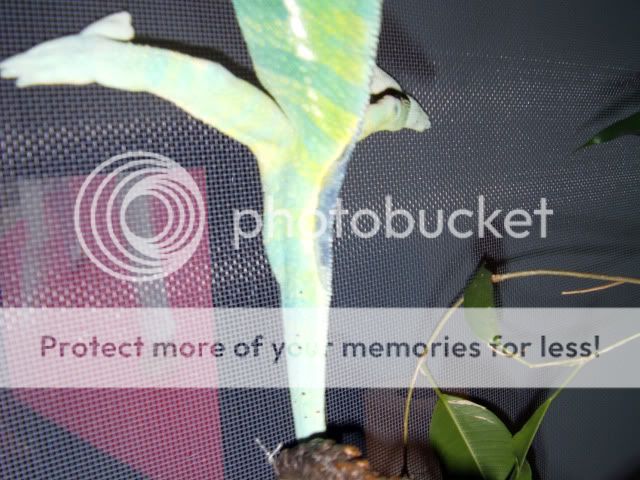Navigation
Install the app
How to install the app on iOS
Follow along with the video below to see how to install our site as a web app on your home screen.
Note: This feature may not be available in some browsers.
More options
You are using an out of date browser. It may not display this or other websites correctly.
You should upgrade or use an alternative browser.
You should upgrade or use an alternative browser.
Can anyone identify *PICS*
- Thread starter glOckcOma
- Start date
bradleymarky
New Member
looks like the same burn my yemen had (wasnt my fault) previous owner
JohnnyMurderus
New Member
i agree it does look like a damaged layer of pigment cells, its weird how its in spots, the only other time i saw a pic of this was more like a lineish oval, was after a serious burn. Usually when this happens its caused by something no? could have been a burn could have been a bite do u mate him? a female could have biten him and your just seeing the damage now from it?
AMGChams
New Member
I dont think it has to do with shedding, this seems to slowly get larger.
I wish I knew what to tell you but I don't. Like the others stated it appeared to be a burn but if it is coming and going I have no clue. I would take him to a Vet better safe than sorry. Good luck and keep us posted.
Texas Panther Man
New Member
I personally cant tell you what that is? You might try pming a vet whos a member on here. His screen name is Renvet I believe. Maybe he can give you a basic idea what your dealing with before taking him in? Is he still eatting and pooping and basking normally? If so I'd watch it and see if it gets bigger. You said you didnt have any other chams so you dont have to worry about quarantining him. I would try to figure out what it is before trying any shotgun remedies you know... I hope you have a knowlegable vet because skin issues are hard to diagnose without taking samples and having them tested by a pathologist thats exp in reptiles.
Carlton
Chameleon Enthusiast
Really!! Nobody trully knows what this is?
Lol! Can it really be, do I finally have the senior members stumped.
I seem to remember reading a thread about a dark spot that comes and goes from day to night as being a localized area that got overheated (but not quite to the level of acute tissue damage). It was sort of like accumulated skin damage from repeated tanning. The chromatophores in the skin lost some of their ability to react to light normally. One problem we have giving our chams a basking spot is that we are exposing them to an unnaturally focused beam of heat compared to the broad heat of sunlight in the wild. The cham's skin is exposed to more intense heat over a smaller area.
I may be way off here, but seem to remember someone speculating that this might be a reason for odd "permanent" skin discoloration. Can anyone remember this?
RenVet
New Member
I'm definitely stumped on this one! My best guess from its appearance is a damaged layer of skin pigmentation cells caused by a previous burn. Even the shape of the defect looks like that of a bulb. How close is your basking spot to the bulb? Has he ever had a burn in this area before? How old is he and has he always been in your care? When did you first notice this? Any changes in his activity/ eating/ drinking/ overall temperament/ and behavior?
Doesn't appear bacterial or fungal simply due to its behavior of coming and going.
This is not a common finding and I would recommend going directly to a specialist herp vet. Any ordinary vet won't have a clue. Chances are, there will be no cure for what is occurring. From the history and images, it looks like a permanent hyperpigmentation issue due to a previous burn, but since there isn't much information on this, it is an educated guess at best.
I hope some of the senior members of this forum will be able to give an insight as to if they have ever seen anything like this before. I certainly have not. Sorry I can't be of more help.
Dr Ren (Vet)
Doesn't appear bacterial or fungal simply due to its behavior of coming and going.
This is not a common finding and I would recommend going directly to a specialist herp vet. Any ordinary vet won't have a clue. Chances are, there will be no cure for what is occurring. From the history and images, it looks like a permanent hyperpigmentation issue due to a previous burn, but since there isn't much information on this, it is an educated guess at best.
I hope some of the senior members of this forum will be able to give an insight as to if they have ever seen anything like this before. I certainly have not. Sorry I can't be of more help.
Dr Ren (Vet)
nicholas
Established Member
I seem to remember reading a thread about a dark spot that comes and goes from day to night as being a localized area that got overheated (but not quite to the level of acute tissue damage). It was sort of like accumulated skin damage from repeated tanning. The chromatophores in the skin lost some of their ability to react to light normally. One problem we have giving our chams a basking spot is that we are exposing them to an unnaturally focused beam of heat compared to the broad heat of sunlight in the wild. The cham's skin is exposed to more intense heat over a smaller area.
I may be way off here, but seem to remember someone speculating that this might be a reason for odd "permanent" skin discoloration. Can anyone remember this?
I had this happen to a t. deremensis taht was accidentally given a basking spot a little to hot. It would come and go but would normally show up at night when he would lighten up. It seems like a layer of chromatiphores damaged due to heat.
Chameleons Northwest
Avid Member
We have had radiation burns that change color day and night like yours does. What lights are you using?
I seem to remember reading a thread about a dark spot that comes and goes from day to night as being a localized area that got overheated (but not quite to the level of acute tissue damage). It was sort of like accumulated skin damage from repeated tanning. The chromatophores in the skin lost some of their ability to react to light normally. One problem we have giving our chams a basking spot is that we are exposing them to an unnaturally focused beam of heat compared to the broad heat of sunlight in the wild. The cham's skin is exposed to more intense heat over a smaller area.
I may be way off here, but seem to remember someone speculating that this might be a reason for odd "permanent" skin discoloration. Can anyone remember this?
glOckcOma
New Member
Okay, he seems to be eating and pooping normally, basking light is a exoterra basking bulb in a dome about 6 inches above his basking area, I have a thermometer there and it reads between 85 and 90 degrees. Unfortunately I can not find a herp vet in my area, the only thing I found was an Avian and Exotic pet clinic. Oh btw I also have a UVB bulb. I noticed this spot last week and never seen him have a burn.
Similar threads
- Replies
- 5
- Views
- 375






